- There are two main uses to which trafficked young apes are put: as pets or as attractions in commercial wildlife facilities (such as disreputable zoos, safari parks, circuses, hotels and use as photo-props).
- The trade is facilitated by celebrities who pose with great ape pets in the press or in social media posts, which act as advertisements that say that owning an ape is “cool.”
- Stiles has been investigating great ape trafficking for the past three years, since being invited to be a co-author of the United Nations report Stolen Apes, released in March 2013 at the 16th CITES Conference of the Parties in Bangkok.
Today his name is Manno and we believe he recently turned four years old, though he is small for his age. Manno has bright, inquisitive eyes, has a penchant for pumpkin seeds and loves to run and play. He has been living alone as the solitary chimpanzee in a small, private zoo in Duhok, Kurdistan, in northern Iraq for about three years.
“Manno turned up in 2013 with wildlife dealers in Damascus, Syria, as a traumatized baby orphan,” Spencer Sekyer told me. Spencer, a teacher in Canada, volunteered to help animals kept in the Duhok Zoo in Kurdistan in late 2014. He fell in love with Manno. “His mother was no doubt killed for bushmeat somewhere in Central Africa and the poachers sold him off to animal traffickers.”
Spencer has been trying to get Manno freed for over a year now.
Spencer showed me a colored piece of paper with prices written on it. “The owner of the Duhok Zoo paid US$15,000 for Manno, and the little chimpanzee has repaid the investment by becoming a very popular attraction. People come from all over the Duhok area to play and have their photographs taken with Manno… spending money.”
The zoo owner dresses the little chimpanzee up in children’s clothes and visitors shower him with food and drink that kids like — junk food. This probably explains why Manno is small for his age.
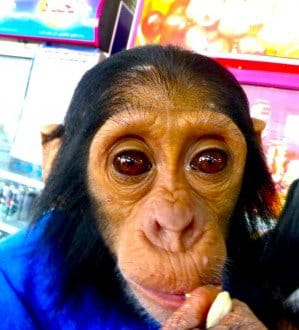

If Manno stays in the zoo, the day will come when he stops being cuddly and playful. He will grow in strength and in aggressiveness, as is normal with chimpanzees. If he is not caged up permanently first, he will attack and no doubt seriously injure someone. His future is not bright.
No bright future
In fact, the future is not bright for any great ape that is trafficked. There are two main uses to which young apes are put: as pets or as attractions in commercial wildlife facilities (such as disreputable zoos, safari parks, circuses, hotels and use as photo-props).
The trade is facilitated by celebrities who pose with great ape pets in the press or in social media posts, which act as advertisements that say that owning an ape is “cool”. The coordinator of the United Nations Great Ape Survival Partnership, Doug Cress, warned that celebrities do not realize that many of the apes were obtained illegally.
“These pictures are seen by hundreds of millions of fans, and it sends the message that posing with great apes — all of which are obtained through illegal means, and face miserable lives once they grow too big and strong to hold — is okay as long as it’s cute. But it’s not. It’s illegal, and it contributes to the destruction of already endangered species,” Cress told The Guardian newspaper.

I have been investigating great ape trafficking for the past three years, since being invited to be a co-author of the United Nations report “Stolen Apes,” released in March 2013 at the 16th CITES Conference of the Parties in Bangkok. The report documents an alarming situation in which more than 1,800 cases were registered of trafficked chimpanzees, bonobos, gorillas, and orangutans being lost to the forests of Africa and Asia between 2005 and early 2012.
This is only a fraction of the real number, as documented cases are those involving seizures by the authorities, and the vast majority of incidents go undetected. More tragically, for every live ape that enters the trade, at least one — the mother — and more than ten can be killed as collateral damage. The number lost is multiplied again because many infants die before reaching the intended destination.
I’ve traveled to West and Central Africa, the Middle East, and most recently made a trip to Thailand, Vietnam, and China, gathering information on this 21st century slave trade. I have also been discovering and monitoring a growing network of online wildlife traffickers, who post photos of their prized wildlife acquisitions and those for sale on social media sites. Unfortunately, recent publicity naming those involved in the illegal trade has resulted in them closing Instagram and Facebook accounts and going underground.
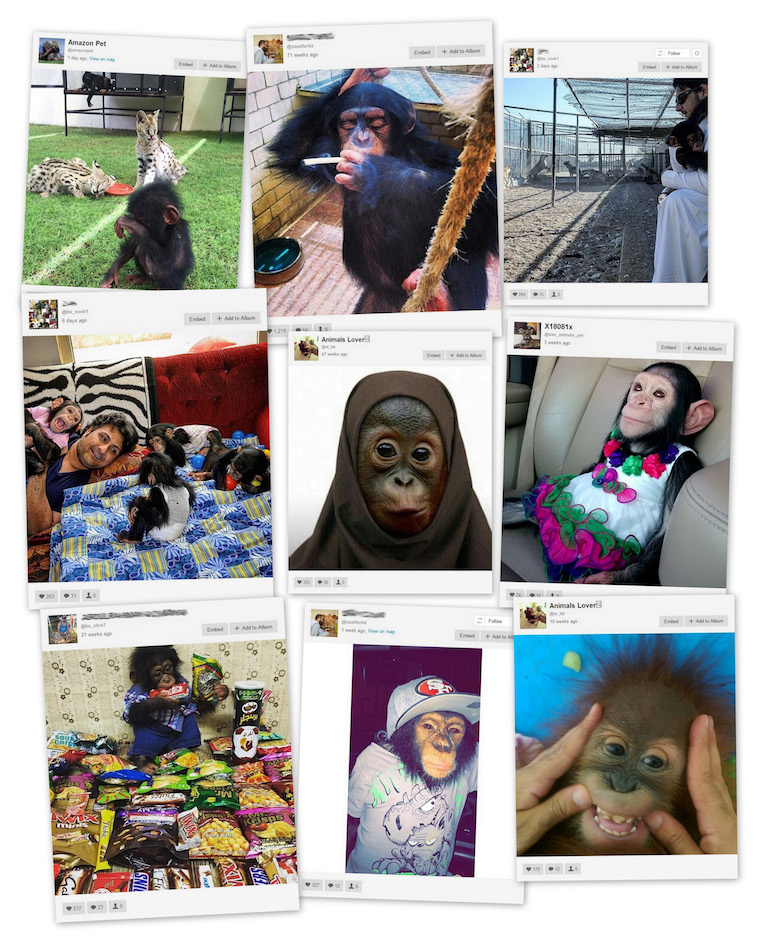
Great apes are becoming increasingly expensive. Of a trade in December last year, Patricia Trichorache from the Cheetah Conservation Fund told me, “Right now there are two baby chimps about to be shipped to Dubai … $40,000 each.” An owner flaunting a $40,000 pet on Facebook or Instagram gains instant prestige. It is common to see friends’ posts saying, “I want one sooo bad,” followed by a string of heart emojis.
Dealers also use social media sites to market their wares. The usual routine is to move to the encrypted WhatsApp or Snapchat to conduct the negotiations after the initial contact is made on a photo post.

In the Gulf countries, infant chimpanzees and orangutans are commonly dressed up in designer clothes, made to wear sunglasses and baseball caps to look cool, and are fed junk food and taught to smoke. I’ve even seen chimpanzees, orangutans, gibbons, and lion cubs all playing together in videos posted on Instagram. Sometimes the play goes too far and the little apes are terrorized, which only elicits laughter from the owner and his friends who gather in carpeted livingrooms to watch the “fun.”
The typical road a slave-ape takes in a commercial zoo or safari park starts with being used as a photo prop. When they get older they are usually trained to perform in some kind of entertainment show and after they reach puberty they are caged up to become a zoo attraction and to breed. Increasingly, dealers and zoos are breeding their own animals.
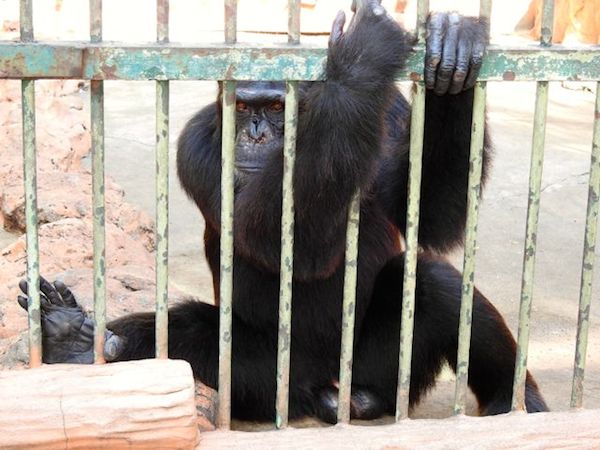
The Egypt excess
Traffickers in Egypt were amongst the first to see the financial advantages in breeding great apes. A woman with dual Egyptian and Nigerian nationality had been trafficking chimpanzees and gorillas out of Kano, in Nigeria, and Guinea since at least the early 1990s, assisted by family members and an Egyptian pediatrician. Two of her clients run holidaymaker hotels in Sharm el Sheikh that used young chimpanzees as photo props with tourists.
Both hotel owners have since the early 2000s established wildlife breeding facilities for great apes and other animals. Chimpanzees and even gorillas are now being smuggled from these breeding centers to other countries in the Middle East and elsewhere. They often go to Damascus first to pick up a CITES re-export permit, which corrupt officials issue for a price, so that they can arrive in the destination country with documentation that makes it look like a legal trade.
A baby chimpanzee from one of the Egyptian breeding facilities was seized in the Cairo airport last year during the security check, being smuggled to Kuwait, where infant great apes are in high demand.
Dina Zulfikar, a well know Egyptian animal welfare activist, followed the case of little Doodoo, as they named him. Dina told me, “The authorities did not follow procedure. They let the trafficker go and did not file a case with the police, as the law requires.” This is an all too typical story in countries with lax law enforcement.
Poor Doodoo now languishes in the Giza Zoo in precarious conditions. Dina recently informed me that his cellmate Bobo died of unknown causes, after another chimpanzee Mouza died some months earlier. The Sweetwaters Chimpanzee Sanctuary in Kenya offered to rescue the little chimpanzee and provide him with lifelong care, but the Egyptian CITES authorities thus far have not responded to the offer. Little Doodoo could join five other chimpanzees at Sweetwaters that were seized in Kenya in 2005 after being refused entry into Egypt, trafficked by the Egyptian-Nigerian woman.


Ian Redmond, head of the U.K.-based Ape Alliance, worked with Dian Fossey and mountain gorillas in the 1980s, before Fossey’s untimely murder, recounted in the film Gorillas in the Mist. I work closely with Ian on the problem of great ape trafficking and he has tried, without success, to rescue the chimpanzees and gorillas held illegally by the Egyptian breeding facilities.
After a visit in 2015 to meet with the great ape breeders in Egypt, Ian told me, “Recent shipments out of Egypt seem likely to be infants bred at G. O.’s [name withheld] facility – if so we are faced with a different problem: essentially, a chimpanzee baby farm where infants are pulled from their mother and bottle-fed to be sold.”

The situation has been reported to the Secretariat of the Convention on International Trade in Endangered Species (CITES), based in Geneva, but they reply that “it is up to the national CITES Management Authority to take action.”
Overlooked Fact
The number of great apes trafficked internationally every year is not large compared to some other species, but when the collateral damage is factored in we are talking about up to 3,000 lives lost from the wild each year, which is close to one percent of the great ape global population.
One important fact is overlooked when simply numbers are used to assess the significance of this extractive industry. Great apes are unlike any other species group. We humans share millions of years of evolutionary history with them and our genetic makeup is surprisingly similar — about 97% with orangutans, 98% with gorillas, and almost 99% with chimpanzees and bonobos. We all belong to the same biological family called Hominidae.
Increasingly, as more behavioral and genetic research is conducted, we are accepting more easily the fact that great apes are very much like humans in so many ways. Just recently, Jane Goodall was quoted as saying, “Chimpanzees taught me how to be a better mother,” indicating just how much great apes are similar to us.
Ian Redmond, who studies ape behavior, says that “Great ape mothers are incredibly protective of their children, which is why they are always killed when poachers go out hunting for infants to sell.”

Beginning in the 1960s, the National Geographic Society was instrumental in funding the research of the Trimates — Jane Goodall, Dian Fossey, and Birutė Galdikas. These three exceptional women carried out long-term research respectively of chimpanzees, mountain gorillas, and orangutans. They made known to the world the surprising fact that characteristics previously thought of as exclusively human are shared by these intelligent, emotionally sensitive great apes.
The Nonhuman Rights Project, led by attorney Steven Wise, has been leading a mission in the United States “to change the common law status of at least some nonhuman animals from mere ‘things,’ which lack the capacity to possess any legal right, to ‘persons,’ who possess such fundamental rights as bodily integrity and bodily liberty, and those other legal rights to which evolving standards of morality, scientific discovery, and human experience entitle them.”
The project is focusing on freeing captive chimpanzees, because a chimpanzee (and other great apes), as Wise argues, “is a cognitively complex, autonomous being who should be recognized as having the legal right to bodily liberty.”
A documentary film about Wise’s work, Unlocking the Cage, premiered at the Sundance Film Festival in January to a packed house and a standing ovation. It will be shown around the world on HBO in July. This film could very well be the hominid version of Blackfish, the film that brought the suffering of captive killer whales in marine parks to the world’s attention, and which has launched a campaign to halt this appalling practice. Sea World announced recently that it would halt killer whale breeding and phase out its theatrical shows using them.
Wise and his colleagues have been battling in court to free the chimpanzees Tommy, Kiko, Hercules, and Leo from inhumane captivity, and recently they gained a huge victory when it was announced that not only Leo and Hercules, but all of the 220 chimpanzees at the University of Louisiana’s New Iberia Research Center, will be freed and sent to a sanctuary. Argentine courts have already ruled that an orangutan named Sandra deserved the basic rights of a “non-human person” and can be freed from a Buenos Aires zoo and transferred to a sanctuary. Likewise, New Zealand and Spain have extended personhood rights to great apes.
Legal systems are increasingly recognizing that it is immoral for nonhuman hominids to be bought and sold, put into captivity and suffer abuse for any reason. Currently, CITES treats great apes like any other animal or plant species. Although classified in Appendix I, which means that commercial trade is prohibited, great apes can be traded for “non-commercial” purposes if they satisfy certain criteria.
Creating exceptions to the prohibition on international trade in great apes tacitly accepts that it is appropriate for humans to own and imprison them. Once in captivity, it is very difficult to monitor whether they are being used for commercial purposes or are being abused in other ways.
Already, hundreds of great apes are being freed in Europe and the U.S. from biomedical research laboratories, and very soon chimpanzees from private commercial zoos in the U.S. will be liberated, due to changes in laws and understanding of the uniqueness of great apes. This is creating a huge problem of where to put them, once liberated. If all commercial wildlife facilities stretching from the Middle East to the Far East are included, it quickly becomes apparent that all great apes cannot be immediately emancipated after changes in law might come into effect.
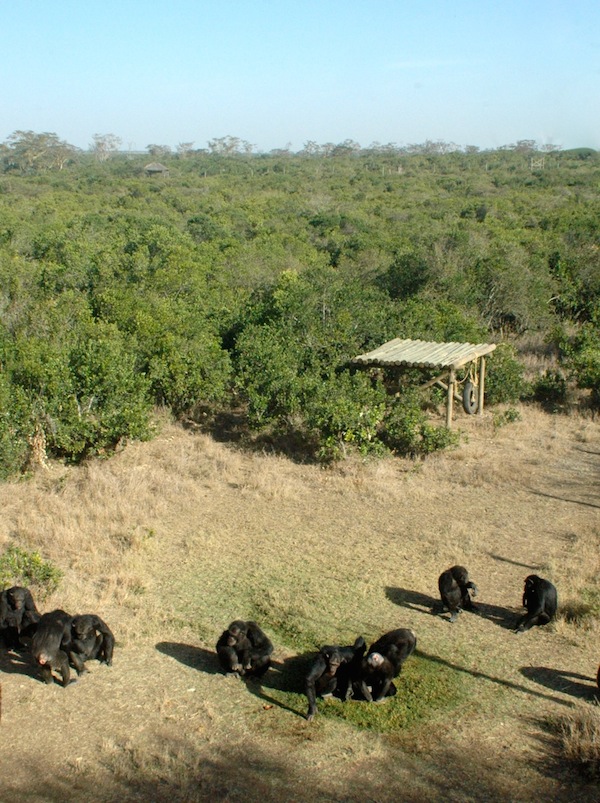
CITES must act
So what is the answer? Change should be planned, gradual, and move in stepped phases. The first step is stopping the illegal trade, which adds every year to the number that eventually will have to be freed. CITES could be instrumental in achieving this, but it is not implementing what needs to be done. Other organizations concerned with great apes also are not doing all that they could be doing. Attempts to strengthen CITES actions to crack down on great ape trafficking at the last CITES Standing Committee meeting in January 2016 were actually undermined by organizations that profess to be helping great apes.
CITES needs to put teeth into the resolution that deals with great apes. There should be a system of registration and monitoring of institutions and individuals that possess great apes, so that new arrivals and movements can be detected. Currently, great apes arrive illegally in countries and are internally transferred and re-exported with little monitoring. Zoo studbooks are often out of date and inaccurate, as my research has found. The CITES Trade Database records only a small fraction of great apes that are traded internationally.
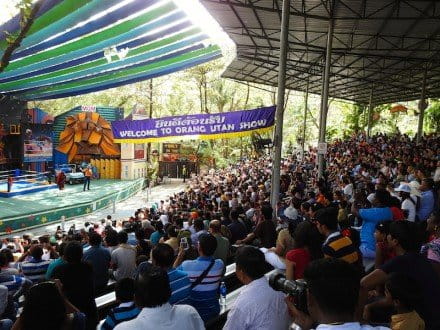

Will Manno and others like him ever be freed to live with others of his kind in a sanctuary, enjoying social life, natural vegetation, and security? Will the day ever come when unthinking people will realize that chimpanzees and orangutans are not playthings and objects of entertainment? They are our family members.
As Dame Jane Goodall says, “In what terms should we think of these beings, nonhuman yet possessing so very many human-like characteristics? How should we treat them? Surely we should treat them with the same consideration and kindness as we show to other humans; and as we recognize human rights, so too should we recognize the rights of the great apes.”
Author’s note: All social media photographs in this article are screen shots from accounts open to the public. In May of 2014 I began working with a project funded by the Arcus Foundation called the Project to End Great Ape Slavery — PEGAS for short. The project is sponsored by the Ol Pejeta Conservancy in Kenya and it works in association with the Sweetwaters Chimpanzee Sanctuary. See FreeTheApes.org. I am also Coordinator of the Ape Alliance Great Ape Trade Working Group. I invite readers to visit our page and sign the pledge to never use a great ape as a pet.